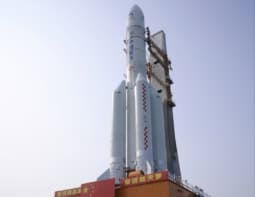NASA are preparing a second test flight of their Ingenuity rotorcraft as early as Thursday following a successful vertical lift-off and landing yesterday. The second flight will aim to reach an altitude of 5 m, then fly laterally about 2 m, come back 2 m before landing softly in the same spot. What is discovered over the next few weeks of test flights will help planetary scientists and engineers plan for future missions to Mars and other planets — including the Dragonfly rotorcraft that will head to Saturn’s moon Titan later this decade.
Ingenuity is a 49 cm-tall helicopter technology demonstration that arrived at Mars 18 February attached to the belly of NASA’s Perseverance rover. On 3 April, Perseverance set the helicopter onto the surface, which opened a 30-Martian-day testing window. Engineers then began preparing Ingenuity for its first flight by testing the battery, insulation, solar panel and rotor blades. Yet when they did so, engineers discovered a software error, which pushed the flight back by roughly a week.
Once that was fixed, Ingenuity lifted off Mars’ surface yesterday for the first time. It reached an altitude of 3 m, hovered for about five seconds, rotated 60 degrees, hovered for another 20 seconds and then 39 seconds later landed softly, taking images as it did so. Those 39 seconds marked the first flight on another planet, a feat that shows future Martian missions and other planetary explorations have the potential to not only stay on the surface but to also move vertically. “This morning, our dream came true,” said MiMi Aung, the Ingenuity Mars Helicopter project manager, during a press briefing hours after the flight.
We’re going to go farther and faster, especially towards the end of the experimental window
MiMi Aung
This first flight was full of unknowns given that Mars has a significantly lower gravity – one-third that of Earth’s – and an extremely thin atmosphere with only 1% the pressure at the surface compared to our planet. “This is a flight that we’ve done hundreds, if not a thousand, times before, but always in a computer simulation,” noted Ingenuity Mars Helicopter chief pilot Håvard Grip in the press briefing. “And to see it now finally happen on Mars and happen exactly how we imagined it, it’s just a really incredible feeling.” Grip also announced that the International Civil Aviation Organization (ICAO) presented NASA with an official ICAO designator “IGY”.
Next steps
There are about two weeks left in the 30-Martian-day testing period and the Ingenuity team expects to fully utilize that time with up to four more flights. They are targeting Thursday for the second flight while a third flight will again reach a height of 5 m, but then fly faster and laterally 50 m, return those 50 m, and land softly. The results of the second and third flights will determine what the mission team plans for the fourth and fifth flights. “We’re going to go farther and faster, especially towards the end of the experimental window,” noted Aung. “We will be pushing the envelope and really stretching and understanding how well we can fly.” Searching for signs of past life on Mars with NASA’s Perseverance rover
Thomas Zurbuchen, associate administrator of NASA’s Science Mission Directorate, reiterated during the briefing that Ingenuity is a technology demonstration. “We really want to be sure that when everything is said and done, we know the full scope of what is possible with that type of flying machine.”



